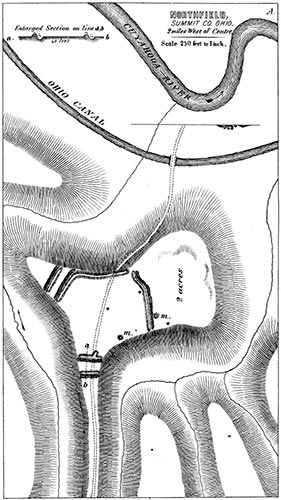PLATE VII. Fig. A.
NORTH FIELD, SUMMIT COUNTY, OHIO.
The engineers who selected the site of this fortification, understood very well the art of turning natural advantages to good account. Why they did not embrace in their plan the whole of the level space within the crest of the bluff, is not easily explained, unless we presume that their numbers were few, and not sufficient to defend the whole. On all sides, the gulleys are from eighty to one hundred and ten feet deep, worn, by running water, into the blue and yellow hard pan that here forms the bluffs of the valley of the Cuyahoga River. The earth is as steep as it will stand; and, in fact, is subject to slides, that lie in terraces, resembling platforms, made by art. Before the ground was cultivated, the ditches are said by Milton Arthur, Esq., the owner of the land, to have been so deep that a man standing in them could not look over the wall.
The soil is gravel, but at about ten feet depth is the impervious "hard pan," or "upland drift," of this region. In the gully on the north the water is permanent at all seasons, running over green shales and sandstones, on which the drift rests. But the ancient inhabitants appear to have dug wells within the fort, at the points indicated by large black dots, which the old settlers say were stoned up, like our wells. On the western face of the bluff, near where the road descends, is a small spring, not reliable at all seasons. At the north end of the ditch of the inner wall, at the neck, there was a narrow space left as a passage into the work, but none in the outer wall. There are low mounds at m, m. The approach is along a sharp ridge called a "hog's back," merely broad enough for a single road track, for the distance of thirty rods, and the sides are as steep as any part of the bluffs adjacent. The points of land across the ravines are on the same level with the work.
It is not very evident why a few rods of ground were cut off by lines at the south-west angle, nor why part of the ditch was made on the inside on the north and west.
It is very remarkable that, while all the works in northern Ohio are of a military character, there are no evidences of attacks by a foe, or of the destruction or overthrow of any of them.
On the west bank of the river, opposite this spot, is another similar work.


